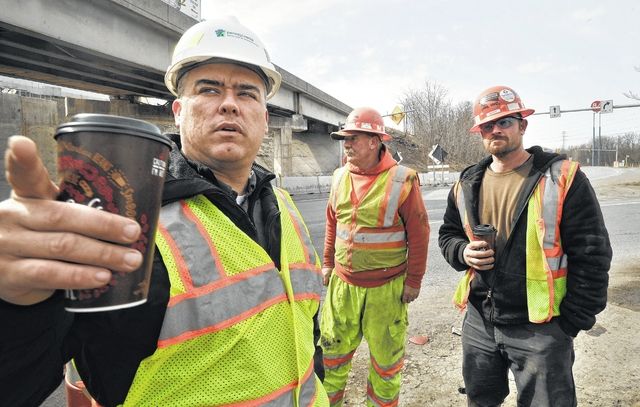Click here to subscribe today or Login.
WILKES-BARRE — The delay just got delayed.
Start of the Cross Valley Expressway Exit 3 ramp project in Plains Township has been pushed back from this week to May 21, but announcement of another River Street project has raised concerns for emergency vehicles accessing Wilkes-Barre General Hospital nearby.
The Wyoming Valley Sanitary Authority soon will begin work to replace a main sewer line on River Street from Courtright Street to Maple Street — a distance of about 600 feet — near the hospital.
And while that work won’t physically overlap with the state Department of Transportation’s year-long Cross Valley effort, the two projects will both be underway this summer and could have an impact on traffic to and from the busy city hospital.
“We are in contact with leaders from EMS organizations to ensure the safety and timely arrival of patients at our hospital,” said Renita Fennick, spokeswoman for hospital parent Commonwealth Health,
“Of the more than 56,000 emergency room visits last year, more than one-fourth of the ER patients arrived by ambulance,” Fennick added.
Cross Valley project
The state Department of Transportation announced Friday that it will begin an $11.3 million project to repair/replace much of the ramp on Exit 3 of the North Cross Valley Expressway leading onto River Street from the West Side.
Work was set to start this Thursday, but PennDOT spokesman James May on Monday said the project won’t begin until Monday, May 21, with anticipated completion in late summer 2019.
PennDOT’s May said no public meetings were held regarding the Cross Valley project, leaving municipalities and emergency responders surprised when they learned of it on Friday.
Plains Township supervisors intend to meet with State Sen. John Yudichak and Rep. Michael Carroll to discuss the project.
Sewer project
Jim Tomaine, WVSA executive director, said the start date has not been set, but it should begin sometime in July and be done in two phases. He said the $1.2 million project will take approximately three weeks to a month to complete.
“We are waiting for PennDOT approval on the traffic patterns,” Tomaine said. “We will also do some more work a little farther up on River Street at a later date.”
Tomaine said Phase I of the project will replace a 30-inch main line and should take about two to three weeks to complete. He said Phase II will be to place another pipe within the main line and will take about a week to finish. He said the two projects can’t be done concurrently. He said Phase II will only require opening the street at two points, the beginning point and the end point.
Cross Valley concerns
May said he traveled the proposed PennDOT detour, measuring it at two miles, He said the addition of a traffic signal at the end of the off ramp of Exit 2 will help keep traffic flowing.
“It’s not a long detour,” May said. “Anytime you have a construction project with a detour you will have delays.”
Commonwealth’s Fennick said hospital officials are working with local PennDOT representatives on an alternative detour to Wilkes-Barre General, particularly for emergency vehicles.
Fennick said an additional concern is the access limitations the planned closure will create for patients driving to the hospital, the same-day surgery center and provider offices, along with employees who commute from the West Side and Back Mountain.
John Campos, executive director of Emergency Medical Services of NEPA in Jenkins Township, said despite what PennDOT says, a two-mile detour will take more than a few minutes to travel.
“Absolutely every second does count,” Campos said. “If you are coming from the West Side and continue to Exit 2 in Wilkes-Barre and come back, two miles may sound like a short distance, but it’s quite a long way when you’re trying to get to the Wilkes-Barre General Hospital.”
Campos said it will take at least five minutes depending on traffic for an emergency vehicle to negotiate the detour route.
“You can’t go 60 miles per hour the entire length of the detour,” he said.
Campos said other factors include the time of day and the amount of traffic at the time of the transport. He said most calls are not critical, but several do occur where time is essential.
“There are times that a minute could make a difference,” Campos said.
Wilkes-Barre Fire Chief Jay Delaney said he has several concerns about the detour, one being the ability of emergency vehicles at the Hollenback Fire Station to respond to calls. He said the additional traffic being detoured to the city via Exit 2 also could cause some issues with the city’s emergency responses.
Delaney said he will talk with PennDOT to have devices installed in the traffic signal that can be activated with the lights on the emergency vehicles — opticons — that change the light from red to green.
WVSA impacts?
Regarding the WVSA River Street project, Campos said detours are more workable and he didn’t expect any major issues for the duration of that project.
Campos plans to meet with Wilkes-Barre City Fire Chief Jay Delaney and others to discuss the upcoming projects and detours.
Delaney said he also has concerns about the WVSA project and will be meeting with them to discuss the proposed detours and other issues.
Delaney said he is concerned about the ability of residents to get to and from their homes and for the businesses along that stretch of River Street.
The chief also said he has concerns for emergency vehicles coming from Nanticoke and Hanover Township to the Wilkes-Barre General Hospital.
“Time is muscle when it comes to heart attacks,” Delaney said.
“As far as treatment, literally minutes and seconds are critical to the work we do,” he added. “This particular road is a main artery to a major hospital.
“This is not just about inconvenience,” the chief said, “this is about potential life and death situations.”





